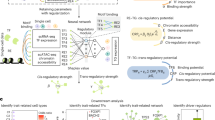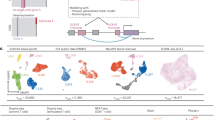Abstract
Imprinting is the preferential expression of one parental allele over the other. It is controlled primarily through differential methylation of cytosine at CpG dinucleotides. Here we combine 285 methylomes and 11,617 transcriptomes from peripheral blood samples with parent-of-origin phased haplotypes, to produce a new map of imprinted methylation and gene expression patterns across the human genome. We demonstrate how imprinted methylation is a continuous rather than a binary characteristic. We describe at high resolution the parent-of-origin methylation pattern at the 15q11.2 Prader–Willi/Angelman syndrome locus, with nearly confluent stochastic paternal methylation punctuated by ‘spikes’ of maternal methylation. We find examples of polymorphic imprinted methylation unrelated (at VTRNA2-1 and PARD6G) or related (at CHRNE) to nearby SNP genotypes. We observe RNA isoform-specific imprinted expression patterns suggestive of a methylation-sensitive transcriptional elongation block. Finally, we gain new insights into parent-of-origin-specific effects on phenotypes at the DLK1/MEG3 and GNAS loci.
This is a preview of subscription content, access via your institution
Access options
Access Nature and 54 other Nature Portfolio journals
Get Nature+, our best-value online-access subscription
$29.99 / 30 days
cancel any time
Subscribe to this journal
Receive 12 print issues and online access
$209.00 per year
only $17.42 per issue
Buy this article
- Purchase on Springer Link
- Instant access to full article PDF
Prices may be subject to local taxes which are calculated during checkout







Similar content being viewed by others
Data availability
We have made available data files with average methylation levels per CpG site (methylationFraction.tsv), P values for PofO-specific methylation per CpG site (PofO_ASM.tsv), and P values for PofO-specific expression per exonic SNP (PofO_ASE.tsv). Data are available at http://figshare.com, https://doi.org/10.6084/m9.figshare.6816917.
References
Babak, T. et al. Genetic conflict reflected in tissue-specific maps of genomic imprinting in human and mouse. Nat. Genet. 47, 544–549 (2015).
Baran, Y. et al. The landscape of genomic imprinting across diverse adult human tissues. Genome Res. 25, 927–936 (2015).
Morison, I. M., Paton, C. J. & Cleverley, S. D. The imprinted gene and parent-of-origin effect database. Nucleic Acids Res. 29, 275–276 (2001).
Ferguson-Smith, A. C. Genomic imprinting: the emergence of an epigenetic paradigm. Nat. Rev. Genet. 12, 565–575 (2011).
McGrath, J. & Solter, D. Completion of mouse embryogenesis requires both the maternal and paternal genomes. Cell 37, 179–183 (1984).
Reik, W. & Walter, J. Genomic imprinting: parental influence on the genome. Nat. Rev. Genet. 2, 21–32 (2001).
Eggermann, T. et al. Imprinting disorders: a group of congenital disorders with overlapping patterns of molecular changes affecting imprinted loci. Clin. Epigenetics 7, 123 (2015).
Kong, A. et al. Parental origin of sequence variants associated with complex diseases. Nature 462, 868–874 (2009).
Inoue, A., Jiang, L., Lu, F., Suzuki, T. & Zhang, Y. Maternal H3K27me3 controls DNA methylation-independent imprinting. Nature 547, 419–424 (2017).
Guo, H. et al. The DNA methylation landscape of human early embryos. Nature 511, 606–610 (2014).
Hanna, C. W. & Kelsey, G. The specification of imprints in mammals. Heredity (Edinb) 113, 176–183 (2014).
Messerschmidt, D. M., Knowles, B. B. & Solter, D. DNA methylation dynamics during epigenetic reprogramming in the germline and preimplantation embryos. Genes Dev. 28, 812–828 (2014).
Smith, Z. D. et al. DNA methylation dynamics of the human preimplantation embryo. Nature 511, 611–615 (2014).
Stewart, K. R., Veselovska, L. & Kelsey, G. Establishment and functions of DNA methylation in the germline. Epigenomics 8, 1399–1413 (2016).
Wang, L. et al. Programming and inheritance of parental DNA methylomes in mammals. Cell 157, 979–991 (2014).
Okae, H. et al. Genome-wide analysis of DNA methylation dynamics during early human development. PLoS Genet. 10, e1004868 (2014).
Proudhon, C. et al. Protection against de novo methylation is instrumental in maintaining parent-of-origin methylation inherited from the gametes. Mol. Cell 47, 909–920 (2012).
Sanchez-Delgado, M. et al. Human oocyte-derived methylation differences persist in the placenta revealing widespread transient imprinting. PLoS Genet. 12, e1006427 (2016).
Court, F. et al. Genome-wide parent-of-origin DNA methylation analysis reveals the intricacies of human imprinting and suggests a germline methylation-independent mechanism of establishment. Genome Res. 24, 554–569 (2014).
Joshi, R. S. et al. DNA methylation profiling of uniparental disomy subjects provides a map of parental epigenetic bias in the human genome. Am. J. Hum. Genet. 99, 555–566 (2016).
Kong, A. et al. Detection of sharing by descent, long-range phasing and haplotype imputation. Nat. Genet. 40, 1068–1075 (2008).
Gudbjartsson, D. F. et al. Large-scale whole-genome sequencing of the Icelandic population. Nat. Genet. 47, 435–444 (2015).
Jónsson, H. et al. Whole genome characterization of sequence diversity of 15,220 Icelanders. Sci. Data 4, 170115 (2017).
Booth, M. J. et al. Quantitative sequencing of 5-methylcytosine and 5-hydroxymethylcytosine at single-base resolution. Science 336, 934–937 (2012).
McCullagh, P. & Nelder, J. A. Generalized Linear Models. 2nd edn, (Chapman and Hall/CRC, London, 1989).
Landan, G. et al. Epigenetic polymorphism and the stochastic formation of differentially methylated regions in normal and cancerous tissues. Nat. Genet. 44, 1207–1214 (2012).
Landau, D. A. et al. Locally disordered methylation forms the basis of intratumor methylome variation in chronic lymphocytic leukemia. Cancer Cell. 26, 813–825 (2014).
Jeltsch, A. & Jurkowska, R. Z. New concepts in DNA methylation. Trends Biochem. Sci. 39, 310–318 (2014).
Romanelli, V. et al. Variable maternal methylation overlapping the nc886/vtRNA2-1 locus is locked between hypermethylated repeats and is frequently altered in cancer. Epigenetics. 9, 783–790 (2014).
Silver, M. J. et al. Independent genomewide screens identify the tumor suppressor VTRNA2-1 as a human epiallele responsive to periconceptional environment. Genome Biol. 16, 118 (2015).
Treppendahl, M. B. et al. Allelic methylation levels of the noncoding VTRNA2-1 located on chromosome 5q31.1 predict outcome in AML. Blood 119, 206–216 (2012).
Bunzel, R. et al. Polymorphic imprinting of the serotonin-2A (5-HT2A) receptor gene in human adult brain. Brain Res. Mol. Brain Res. 59, 90–92 (1998).
Giannoukakis, N., Deal, C., Paquette, J., Kukuvitis, A. & Polychronakos, C. Polymorphic functional imprinting of the human IGF2 gene among individuals, in blood cells, is associated with H19 expression. Biochem. Biophys. Res. Commun. 220, 1014–1019 (1996).
Xu, Y., Goodyer, C. G., Deal, C. & Polychronakos, C. Functional polymorphism in the parental imprinting of the human IGF2R gene. Biochem. Biophys. Res. Commun. 197, 747–754 (1993).
Docherty, L. E. et al. Genome-wide DNA methylation analysis of patients with imprinting disorders identifies differentially methylated regions associated with novel candidate imprinted genes. J. Med. Genet. 51, 229–238 (2014).
Rochtus, A. et al. Genome-wide DNA methylation analysis of pseudohypoparathyroidism patients with GNAS imprinting defects. Clin. Epigenetics 8, 10 (2016).
Lev Maor, G., Yearim, A. & Ast, G. The alternative role of DNA methylation in splicing regulation. Trends Genet. 31, 274–280 (2015).
Shukla, S. et al. CTCF-promoted RNA polymerase II pausing links DNA methylation to splicing. Nature 479, 74–79 (2011).
Cowley, M., Wood, A. J., Böhm, S., Schulz, R. & Oakey, R. J. Epigenetic control of alternative mRNA processing at the imprinted Herc3/Nap1l5 locus. Nucleic Acids Res. 40, 8917–8926 (2012).
Wood, A. J. et al. Regulation of alternative polyadenylation by genomic imprinting. Genes Dev. 22, 1141–1146 (2008).
Astle, W. J. et al. The allelic landscape of human blood cell trait variation and links to common complex disease. Cell 167, 1415–1429.e19 (2016).
Perry, J. R. et al. Parent-of-origin-specific allelic associations among 106 genomic loci for age at menarche. Nature 514, 92–97 (2014).
Mantovani, G. Clinical review: pseudohypoparathyroidism: diagnosis and treatment. J. Clin. Endocrinol. Metab. 96, 3020–3030 (2011).
Kelsey, G. Imprinting on chromosome 20: tissue-specific imprinting and imprinting mutations in the GNAS locus. Am. J. Med. Genet. C Semin. Med. Genet. 154C, 377–386 (2010).
Krueger, F. & Andrews, S. R. Bismark: a flexible aligner and methylation caller for Bisulfite-Seq applications. Bioinformatics 27, 1571–1572 (2011).
Strimmer, K. fdrtool: a versatile R package for estimating local and tail area-based false discovery rates. Bioinformatics 24, 1461–1462 (2008).
Simpson, J. T. et al. Detecting DNA cytosine methylation using nanopore sequencing. Nat. Methods 14, 407–410 (2017).
Ziebarth, J. D., Bhattacharya, A. & Cui, Y. CTCFBSDB 2.0: a database for CTCF-binding sites and genome organization. Nucleic Acids Res. 41, D188–D194 (2013).
Dunham, I. et al. An integrated encyclopedia of DNA elements in the human genome. Nature 489, 57–74 (2012).
Stacey, S. N. et al. New basal cell carcinoma susceptibility loci. Nat. Commun. 6, 6825 (2015).
Dobin, A. et al. STAR: ultrafast universal RNA-seq aligner. Bioinformatics 29, 15–21 (2013).
Shabalin, A. A. Matrix eQTL: ultra fast eQTL analysis via large matrix operations. Bioinformatics 28, 1353–1358 (2012).
Acknowledgements
This study was funded by deCODE genetics/AMGEN Inc.
Author information
Authors and Affiliations
Contributions
F.Z., O.T.M., U.T., B.V.H., S.N.S., and K.S. designed the study and interpreted the results. D.N.M., N.J.W., T.J.M., O.T.M., and A.S. carried out the sequencing and genotyping. J.G., T.R., I.J., H.H., G.I.E., O.S., I.O., U.T., and S.N.S. assessed the participants and collected the data. F.Z., G.H.H., S.A.G., P.M., H.I., S.K., K.F.A., A.H., G.M., D.F.G., B.V.H., and S.N.S. carried out the statistical and bioinformatics analysis. F.Z., S.N.S., and K.S. drafted the manuscript. All authors contributed to the final version of the paper.
Corresponding authors
Ethics declarations
Competing interests
All deCODE authors are employees of the biotechnology company deCODE genetics/AMGEN. N.J.W. and T.J.M. are employees of Cambridge Epigenetix Ltd. Cambridge Epigenetix Ltd retains the rights for diagnostic use of the oxBS-seq technology and receives royalties from the sale of oxBS kits under the terms of a partnership agreement with NuGEN Technologies.
Additional information
Publisher’s note: Springer Nature remains neutral with regard to jurisdictional claims in published maps and institutional affiliations.
Supplementary information
Supplementary Text and Figures
Supplementary Figures 1–18
Supplementary Tables
Supplementary Tables 1–9
Rights and permissions
About this article
Cite this article
Zink, F., Magnusdottir, D.N., Magnusson, O.T. et al. Insights into imprinting from parent-of-origin phased methylomes and transcriptomes. Nat Genet 50, 1542–1552 (2018). https://doi.org/10.1038/s41588-018-0232-7
Received:
Accepted:
Published:
Issue Date:
DOI: https://doi.org/10.1038/s41588-018-0232-7
This article is cited by
-
A comparison of methods for detecting DNA methylation from long-read sequencing of human genomes
Genome Biology (2024)
-
A novel imprinted locus on bovine chromosome 18 homologous with human chromosome 16q24.1
Molecular Genetics and Genomics (2024)
-
Phenome-wide analyses identify an association between the parent-of-origin effects dependent methylome and the rate of aging in humans
Genome Biology (2023)
-
DNA 5-methylcytosine detection and methylation phasing using PacBio circular consensus sequencing
Nature Communications (2023)
-
Haplotype-aware pantranscriptome analyses using spliced pangenome graphs
Nature Methods (2023)



